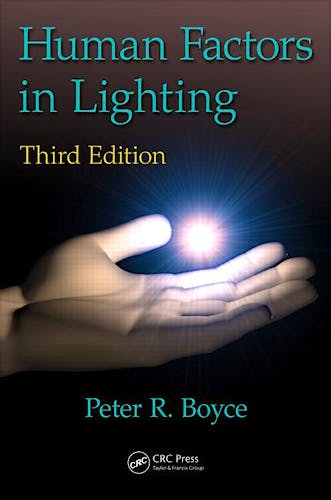

No hay productos en el carrito



Human Factors in Lighting
Boyce, P.
1ª Edición Abril 2014
Inglés
Tapa dura
703 pags
1056 gr
16 x 24 x 4 cm
ISBN 9781439874882
Editorial CRC PRESS
LIBRO IMPRESO
-5%
97,34 €92,47 €IVA incluido
93,60 €88,91 €IVA no incluido
Recíbelo en un plazo de
2 - 3 semanas
Description
The availability of electric lighting has changed the lives of people the world over, yet as a major user of electricity it has come under increasing scrutiny in recent years. This scrutiny has focused largely on the environmental consequences, with little consideration of thebenefits of lighting. Human Factors in Lighting, Third Editionrestores some balance to the discussion by examining the ways in which people interact with lighting. These interactions influence the ability to perform visual tasks; the perception of people, objects, and spaces; human comfort and behavior; as well as human health and safety. It is only by understanding how to use light to achieve these ends that lighting can be provided effectively and efficiently to the benefit of all.
See What’s New in the Third Edition:
- New chapters on the non-image-forming system, lighting for pedestrians, light pollution, and lighting and electricity use
- Revision of all other chapters to update them to take into account the advances that have been made in our understanding of the effects of light on people over the last decade
- Integration of the combined effects of light via the visual and non-image-forming systems on performance and perception
The book covers both the visual and the non-visual effects of light on people as well as the benefits of lighting and the costs it imposes on the environment. It details the consequences of exposure to lighting or lighting technology and the role of exposure to light on suchbasic functions of the body as circadian rhythms. The author combines information from many different sources and integrates them into a coherent overview of lighting practice that can be used to develop better lighting solutions at a lower environmental cost.
Features
- Covers the fundamentals, generalities, and specific applications
- Integrates the effects of lighting on the visual and non-image-forming systems as they affect task performance and perception
- Gives priority to people over lighting technology
- Provides up-to-date reviews of the role of lighting in visual performance, visual discomfort and visual perception
- Delivers detailed reviews of how the lighting of offices, industry, and roads affects people
- Examines the role of lighting as it affects human safety, crime, the elderly, and health
- Explores how people react to light pollution and how they use lighting controls
Contents
Fundamentals
Light
Introduction
Light and Radiation
CIE Standard Observers
Photometric Quantities
Some Limitations
Colorimetric Quantities
Sources of Light
Control of Light Distribution
Control of Light Output
Summary
Visual System
Introduction
Structure of the Visual System
Continuous Adjustments of the Visual System
Capabilities of the Visual System
Perception through the Visual System
Summary
Non-Image-Forming System
Introduction
Some Physiology
Circadian Timing System
Characteristics of the Circadian Timing System
Awakening System
Pupil Size
Problems and Potential
Summary
Generalities
Lighting and Work
Introduction
Overview
Light, Work, and the Visual System
Light, Work, and the Non-Image-Forming System
Light, Work, Mood, and Motivation
Summary
Lighting and Visual Discomfort
Introduction
Characteristics of Visual Discomfort
General Causes of Visual Discomfort
Specific Causes of Visual Discomfort
Discomfort, Performance, and Behaviour
Visual Discomfort and Lighting Quality
Summary
Lighting and the Perception of Spaces and Objects
Introduction
Simple Perceptions
Higher-Order Perceptions
Perception of Objects
Summary
Specifics
Lighting for Offices
Introduction
Illuminance
Light Sources for Office Lighting
Lighting Systems
Lighting Controls
Summary
Lighting for Industry
Introduction
Problems Facing Lighting in Industry
General Lighting
Localized and Task Lighting
Visual Inspection
Special Situations
Summary
Escape Lighting
Introduction
Escape Lighting in Context
Operating Conditions
Exit Signs
Escape Route Lighting
Special Situations
Escape Lighting in Practice
Summary
Lighting for Driving
Introduction
Vehicle Forward Lighting
Vehicle Signal Lighting
Road Lighting
Markings, Signs, and Traffic Signals
Summary
Lighting for Pedestrians
Introduction
What Pedestrians Want from Lighting
Lighting Criteria
Lighting for Safe Movement
Lighting for Security
Lighting, Comfort, and Attraction
Completing the Picture
Summary
Lighting and Crime
Introduction
Some History
Lighting as a Crime Prevention Measure
The Reason Why
Essential Characteristics of Lighting
Special Situations
Generalization and Value
Summary
Lighting for the Elderly
Introduction
Optical Changes with Age
Neural Changes with Age
Vision Loss
Effects of Age on Visual Capabilities
Effects of Age on Real Visual Tasks
Effects of Age on the Circadian Timing System
What Can Be Done to Offset the Effects of Age?
Summary
Light and Health
Introduction
Light as Radiation
Light Operating through the Visual System
Light Operating through the Circadian Timing System
Unresolved Issues
Summary
Light Pollution
Introduction
Forms of Light Pollution
Causes of Light Pollution
Consequences of Light Pollution
Reactions to Light Pollution
Limiting Light Pollution
The Future
Summary
Lighting and Electricity Consumption
Introduction
Legal Status
Trends in Lighting Regulation
Trends in Lighting Recommendations
Design
Load Shedding
Summary
The Way Ahead
Introduction
Background
Problems with New Technology
Problems with New Knowledge
Problems with Increased Pressure
Research Approaches
New Tools
Evaluating Research
Summary
References
Index
© 2025 Axón Librería S.L.
2.149.0